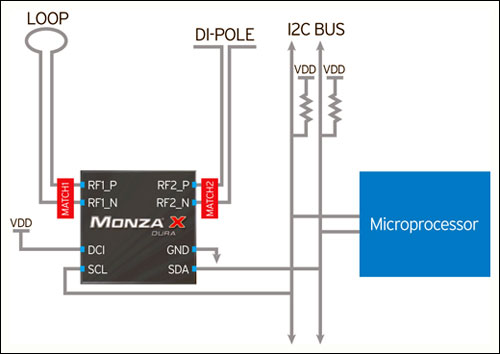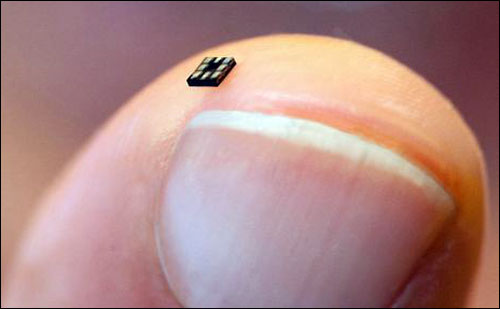Seattle-based RFID hardware provider Impinj has announced an EPC Gen 2 passive ultrahigh-frequency (UHF) tag chip developed for embedded applications, such as programming consumer electronics or updating electronic price-label data. The Monza X Dura integrated circuit (IC) comes in two versions, based on memory capacity. The X-2K Dura model, available now, comes with 2 kilobits of memory, while the X-8K Dura version, slated for release in August 2012, will feature 8 kilobits. When a Monza X chip is installed in a laptop PC, printer or other electronic device, an RFID reader can be used to upload data to that device (such as programming instructions) by encoding that information to chip.
An RFID interrogator can be used to write data to the Monza X chip’s memory, whether an electronic device is powered on or off. In this way, someone could read and configure information on the chip through a box when it is switched off. When the device is powered up, its processor can draw the data from the RFID chip, using a standard I²C bus-wired connection, and then adjust its settings according to the instructions encoded to that IC.
During the past seven years, Impinj has worked with electronic device processor manufacturer Intel to develop the Monza X chips, for use with Microsoft Windows 8-based processors for tablet computers to be released later this year, explains Kerry Krause, Impinj’s VP of marketing. As part of that development, Intel demonstrated the Monza X chips in thousands of tablets as a proof-of-concept to customers, retailers and other end users and attendees of the RFID Journal LIVE! 2012 conference and exhibition, where the design was given the RFID Journal Award for Best Use of RFID in a Product or Service (see RFID Journal Announces Winners of Its Sixth Annual Awards). The ICs were also tested by Windows and Android software developers to incorporate the technology into their applications. Impinj is now making the chips commercially available to other customers.
Impinj is marketing the chips to provide several use cases, Krause says. In one scenario, the chips could be built into electronic devices, such as those using Intel processors. This would enable the programming of such a device at the point of sale, without it being unpacked from its box. In another use case, the chips could be embedded in electronic shelf labels or signs. In that way, a retailer could update the price displayed by an electronic shelf label, by issuing instructions to the Monza X chip, which would forward those instructions to the e-label’s processor to change a price displayed on the unit’s LCD or LED screen. At least one major retailer is considering the technology for price displays within its stores, Krause says, though that company cannot yet be named.
For consumer electronics, Intel envisions using the Monza X chip to enable the purchaser of an electronic device to register a pre-installed software application so that it could be utilized as soon as that device was powered on, or to configure the device’s settings, such as the language of the user. The chip could be employed to disable the device until sold by an authorized retailer equipped with an RFID reader, such as a store employee at the point of sale. In that way, the system would be able to reduce the amount of theft along the supply chain. In this scenario, the product manufacturer would store a key in the chip’s memory vault, according to Nikhil Deulkar, Impinj’s senior product line manager. While still in the supply chain, for example, a tablet or other device could be programmed during manufacture to remain in a “coma” or dormant state until receiving a code at a retail store, as the device was purchased. The chip’s key could allow it to retain partial functionality, so that the product could still perform as a demonstration unit, but lack full functionality until a code was received at the point of sale. In addition, products could also be rendered unusable if taken outside of a permitted location, such as a school, library or laboratory.
For the purpose of maintaining the chip’s data security, Impinj has included its QT technology, which enables a user to set up protected blocks of memory, thereby making it impossible for certain information stored on the chip to be read without authorization. In that way, data could be stored but remain inaccessible to unauthorized RFID readers.

The Monza X chip supports two tag antennas, Deulkar says, thereby providing the ability to use a small antenna on the circuit board for reading and writing to the chip during a device’s manufacture, as well as a long-range antenna just inside the product’s exterior surface, for use after the product has been fully assembled or boxed or shelved.
What’s more, the solution will also be used to link RFID data to automotive systems. Fuel-management company QuikQ is developing a system for its customers to enable the collection of data via RFID while a vehicle is being fueled. In this case, a Monza X-2K Dura chip will be embedded under the vehicle’s hood, in order to collect odometer readings and other information from its onboard computer. That data could then be captured using an RFID reader every time the vehicle pulls into an RFID-enabled fueling station, such as those installed at Love’s Travel Stops and Country Stores (see Love’s Tries RFID for Automating Fuel Payments). QuikQ’s embedded-chip solution is not yet commercially available, says Marty Faber, the company’s director of business development, but the firm intends to begin testing it by late July, with a commercial launch expected at the end of this year.
In the meantime, Krause reports, consumer electronics brand owners are developing products from Intel’s computing reference designs, in order to take advantage of the platform. However, he notes, the companies involved cannot yet be named.
Michael Liard, the auto-ID director at analyst firm VDC Research, predicts that the prevalence of RFID use in consumer electronics could be meaningful not only to the RFID market, but also to the consumer electronics sector. While the technology is initially being developed for tablets and printers, he says, it could impact a variety of other products as well, including laptops, personal computers, cameras and e-readers.
According to Liard, the embedded RFID tags offer two primary benefits for use in consumer electronics: activation (along with authentication) and personalization. He suggests a scenario in which a consumer might purchase a tablet for her mother, and could first have that device activated at the point of sale (in this way, the system could discourage thieves from stealing the tablet as it traversed the supply chain, when it would be inoperable). She could then have it personalized—for example, it could be configured to a parent’s native language, store a gift card, and display with a welcome message referencing her by name and wishing her a happy birthday.
Other manufacturers of RFID ICs have launched EPC Gen 2 UHF tag chips designed to be embedded in electronic devices. RFID chip maker NXP Semiconductors offers an I²C-compatible Ucode chip that it first unveiled in 2010 (see NXP to Unveil New UHF, HF Chips). EM Microelectronic recently launched its EM4325 battery-assisted passive RFID chip, which Intermec has embedded in its latest printer models (see Intermec Simplifies Printer Configuration Via RFID). While several RFID chips have already been on the market with embedded functionality, Liard says, Intel’s involvement “will really help drive adoption.”




